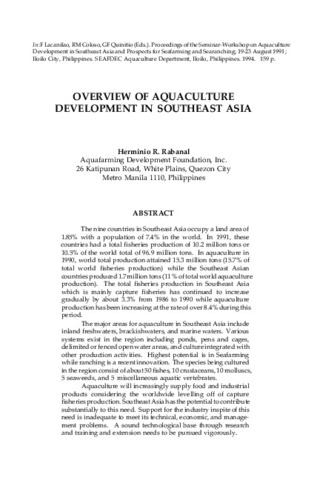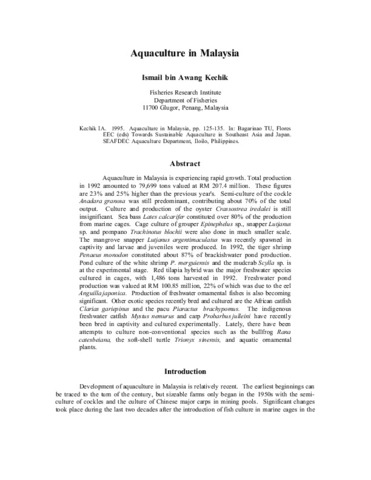Overview of aquaculture development in Southeast Asia
- Global styles
- MLA
- Vancouver
- Elsevier - Harvard
- APA
- Help
Share
นามธรรม
The nine countries in Southeast Asia occupy a land area of 1.85% with a population of 7.4% in the world. In 1991, these countries had a total fisheries production of 10.2 million tons or 10.5% of the world total of 96.9 million tons. In aquaculture in 1990, world total production attained 15.3 million tons (15.7% of total world fisheries production) while the Southeast Asian countries produced 1.7 million tons (11 % of total world aquaculture production). The total fisheries production in Southeast Asia which is mainly capture fisheries has continued to increase gradually by about 3.3% from 1986 to 1990 while aquaculture production has been increasing at the rate of over 8.4% during this period.The major areas for aquaculture in Southeast Asia include inland freshwaters, brackishwaters, and marine waters. Various systems exist in the region including ponds, pens and cages, delimited or fenced open water areas, and culture integrated with other production activities. Highest potential is in Seafarming while ranching is a recent innovation. The species being cultured in the region consist of about 50 fishes, 10 crustaceans, 10 molluscs, 5 seaweeds, and 5 miscellaneous aquatic vertebrates.Aquaculture will increasingly supply food and industrial products considering the worldwide levelling off of capture fisheries production. Southeast Asia has the potential to contribute substantially to this need. Support for the industry inspite of this need is inadequate to meet its technical, economic, and management problems. A sound technological base through research and training and extension needs to be pursued vigorously.
การอ้างอิง
Rabanal, H. R. (1994). Overview of aquaculture development in Southeast Asia. In F. Lacanilao, R. M. Coloso, & G. F. Quinitio (Eds.), Proceedings of the Seminar-Workshop on Aquaculture Development in Southeast Asia and Prospects for Seafarming and Searanching; 19-23 August 1991; Iloilo City, Philippines. (pp. 53-67). Tigbauan, Iloilo, Philippines: Aquaculture Department, Southeast Asian Fisheries Development Center.
Type
Conference paperISBN
971851127Xคอลเลกชัน
- ADSEA '91 [21]
Related items
Showing items related by title, author, creator and subject.
-
Aquaculture in Malaysia
Kechik, Ismail bin Awang. (Aquaculture Department, Southeast Asian Fisheries Development Center, 1995)Aquaculture in Malaysia is experiencing rapid growth. Total production in 1992 amounted to 79,699 tons valued at RM 207.4 million. These figures are 23% and 25% higher than the previous year's. Semi-culture of the cockle ... -
Aquaculture development in Thailand
Sirikul, Boonsong; Luanprida, Somsak; Chaiyakam, Kanit; Sriprasert, Revadee (Aquaculture Department, Southeast Asian Fisheries Development Center, 1988)Aquaculture practised in Thailand is in the form of pond culture and cage culture in freshwater, brackishwater and coastal areas. The main species cultured include freshwater prawns, brackishwater shrimp, cockles, mussels, ... -
The Philippine aquaculture industry
Camacho, Arsenio S.; Macalincag-Lagua, Natividad (Aquaculture Department, Southeast Asian Fisheries Development Center, 1988)The aquaculture sector of the Philippine fishing industry registered the highest growth rate of 12.5% in 1977-1986. The contribution of aquaculture to the total fish production was equivalent to 24% in 1986 compared to ...






